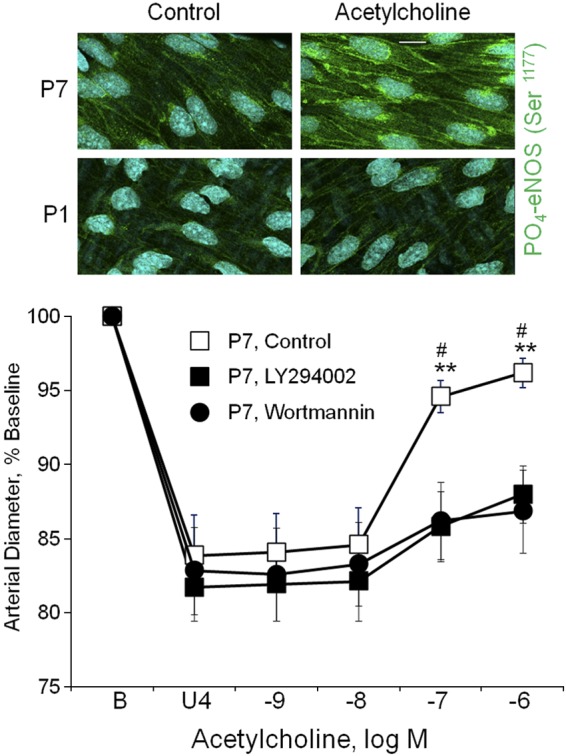Fig. 3.

Endothelial signaling in neonatal arteries. Top: representative LSM fluorescent images demonstrating the effect of acetylcholine (10−6 M) on the Ser1177 phosphorylated form of endothelial NO synthase (PO4-eNOS Ser1177) in endothelial cells of P1 and P7 arteries. PO4-eNOS Ser1177 is represented in green, while nuclei are colored light blue. The white line represents 10 μm. Acetylcholine significantly increased levels of PO4-eNOS Ser1177 in endothelial cells of P7 arteries (to 149.0 ± 5.6% of control, P < 0.001, n = 8) but not in P1 arteries (to 100.8 ± 3.3% of control, P = NS, n = 8). There was no significant difference in the basal control levels of PO4-eNOS Ser1177 between P1 and P7 arteries (basal level in P7 arteries was 101.9 ± 7.7% of the level observed in P1 arteries, P = NS, n = 5). Bottom: effects of phosphoinositide 3-kinase (PI3K) inhibition with wortmannin (3 × 10−7 M) or LY294002 (5 × 10−5 M) on dilator responses to acetylcholine in P7 carotid arteries. Paired isolated arteries were analyzed in a microperfusion system at a transmural pressure of 20 mmHg and treated with or without a PI3K inhibitor. To observe dilation, arteries were initially constricted to ∼80% of baseline diameter with the thromboxane receptor agonist U46619 (U4). Functional responses are expressed as a percentage of the baseline diameter (B) and presented as means + SE (n = 7 for each inhibitor). For statistical analysis, * symbols indicate significant difference with arteries treated with wortmannin, and # symbols indicate significant difference with arteries treated with LY294002. In each case, 1 symbol = P < 0.05; 2 symbols = P < 0.01. The inhibitors markedly reduced dilation to acetylcholine.
